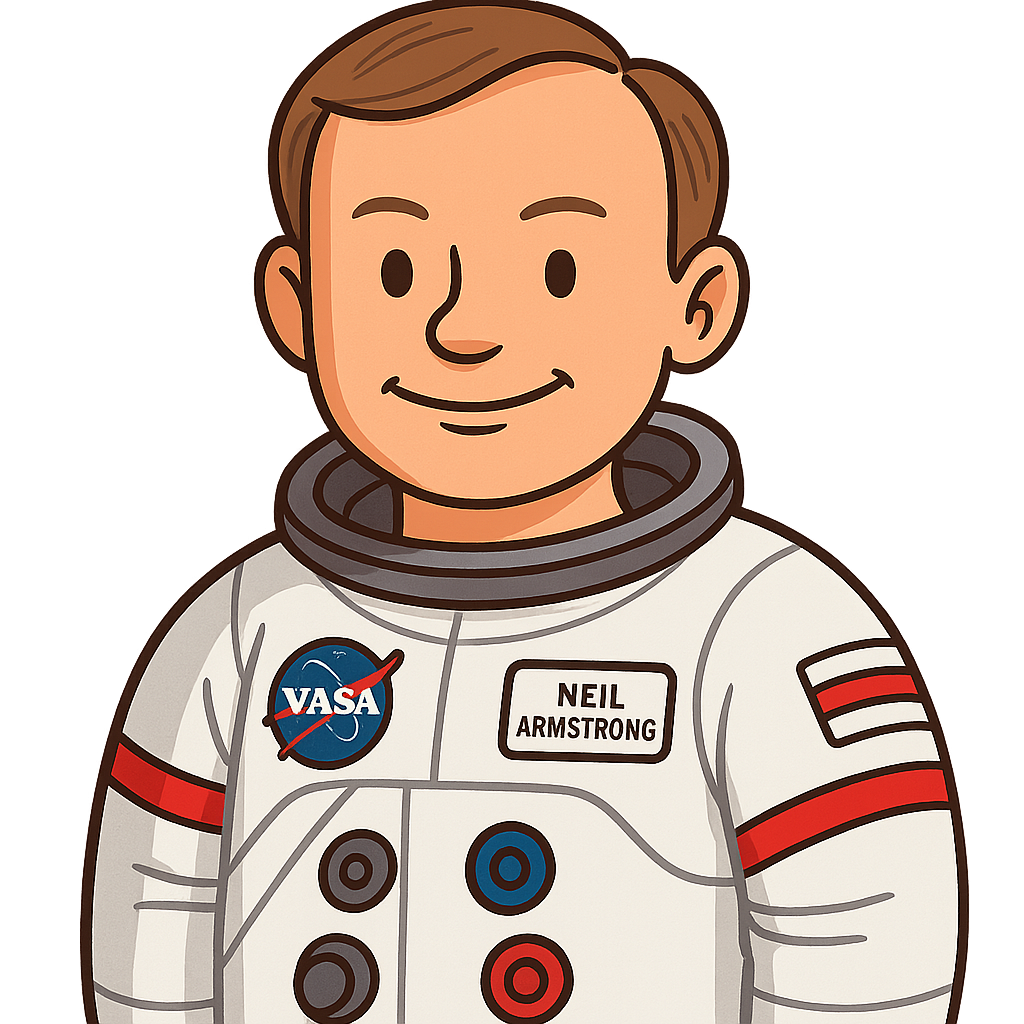Neil Armstrong
Have you ever looked up at the night sky and dreamed of touching the Moon? When I was a boy, that dream felt as far away as the stars themselves. I was born in Wapakoneta, Ohio, on August 5, 1930. The world was a different place then, but my fascination was with the sky. I fell in love with airplanes from the moment my father took me on my first flight when I was just six years old. The feeling of lifting off the ground and soaring above the fields of Ohio was pure magic. I spent hours building and flying model airplanes, learning everything I could about aerodynamics. That passion drove me to get my pilot’s license in 1946, when I was only sixteen—I could fly a plane before I could even legally drive a car. My love for flight led me to Purdue University to study aeronautical engineering. My studies were interrupted when I was called to serve as a U.S. Navy pilot during the Korean War, starting in 1949. Flying 78 combat missions taught me how to think clearly and act decisively under incredible pressure. Those lessons in the cockpit, with life on the line, were some of the most important I ever learned. They shaped me into the pilot and person I would need to be for the challenges that lay ahead.
After the war, I finished my degree and became a test pilot. It was a thrilling and dangerous job. I flew experimental aircraft, pushing them to their limits to see what they could do. I even flew the X-15 rocket plane, a machine that soared to the very edge of space, over 40 miles above the Earth. This was during the 1960s, a time of great competition between the United States and the Soviet Union known as the 'Space Race.' In 1961, President John F. Kennedy set a bold goal: to land a man on the Moon and return him safely to the Earth before the decade was out. It was a challenge that captured the imagination of the world, and I knew I wanted to be part of it. In 1962, I was selected to be in NASA's second group of astronauts. The training was the most intense I had ever experienced. We spent years learning everything from orbital mechanics to survival skills. My first trip to space was as commander of the Gemini 8 mission in March 1966. What started as a successful mission quickly turned into a life-threatening emergency. A stuck thruster sent our spacecraft into a wild, uncontrollable spin, tumbling through space. Using my experience as a test pilot, I stayed calm, shut down the main system, and used the reentry thrusters to stabilize our capsule. We had to cut our mission short, but we made it home safely. It was a terrifying experience, but it proved I could handle a crisis when it mattered most.
Three years later, I was given the honor of commanding Apollo 11, the mission that would attempt to fulfill President Kennedy's promise. My crewmates were two brilliant and dedicated men: Buzz Aldrin, who would walk on the Moon with me, and Michael Collins, who would pilot our command module in orbit around the Moon. But our team was much bigger than just the three of us. Our mission was the result of the tireless work of over 400,000 engineers, scientists, and technicians. On July 16, 1969, we sat atop the most powerful rocket ever built, the Saturn V. When it ignited, the entire world seemed to shake. The force pressed me back into my seat as we thundered away from Earth. Four days later, Buzz and I were in our Lunar Module, which we had named the Eagle, preparing for the most critical part of our journey. As we descended toward the surface, alarms began to sound. The computer was guiding us toward a crater filled with huge, sharp boulders. With our fuel running dangerously low—we had less than a minute left—I took manual control. I searched for a safe spot, flying the Eagle like a helicopter, until I found a smooth, clear patch of ground. On July 20, 1969, with the world holding its breath, I set our craft down gently. I keyed the microphone and spoke the words that everyone was waiting to hear: 'Houston, Tranquility Base here. The Eagle has landed.'
Looking out the window of the Eagle, I saw a landscape unlike anything on Earth. It was stark, beautiful, and utterly alien. I called it 'magnificent desolation.' A few hours later, I opened the hatch and slowly made my way down the ladder. As my boot touched the fine, powdery lunar soil, I spoke words that I hoped would capture the importance of the moment: 'That's one small step for a man, one giant leap for mankind.' I meant that while my physical step was small, this achievement represented a monumental advance for all of humanity. Walking on the Moon was an incredible feeling. The gravity is only one-sixth of Earth's, so I could bounce and leap with every step. Far above us, I could see our home planet, a breathtakingly beautiful blue and white marble hanging in the blackness of space. After my time as an astronaut, I lived a quiet life. I became a professor of engineering and enjoyed my time on my farm in Ohio. My life came to an end in 2012, but the legacy of Apollo 11 lives on. It is a reminder that when we dare to dream, work together with dedication and courage, and push the boundaries of what seems possible, there is no limit to what humanity can achieve.
Reading Comprehension Questions
Click to see answer
